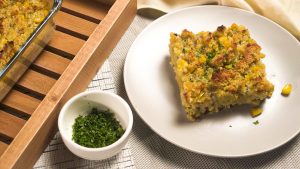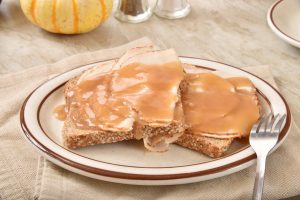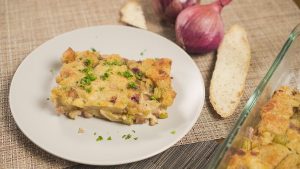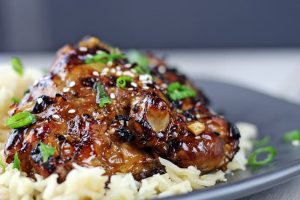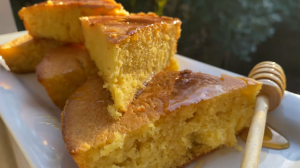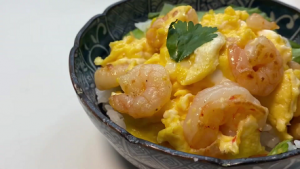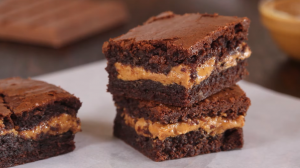This ultimate Thanksgiving turkey recipe is a feast for the senses. With a rich, savory turkey as the star of the show, complemented by a homemade stock and gravy, it's sure to become a holiday tradition. The key to its incredible flavor is the brining process, which helps to tenderize the meat and infuse it with a wealth of flavor, while the roasting technique results in a beautifully browned, crispy skin.
Some of the ingredients in this recipe may not be readily available in your home kitchen. 'Turkey carcass' and 'Rendered turkey fat' are two such ingredients that might need a trip to the supermarket or a special request to your butcher. The turkey carcass is used to create a flavorful stock, while the rendered turkey fat is integral to the gravy's rich taste. The 'Granulated garlic' and 'Sage' used in this recipe can also be found in the herbs and spices aisle of most supermarkets.
Ingredients for the Ultimate Thanksgiving Turkey
Turkey: The star of this recipe, a whole turkey is used here, with the breasts, thighs, wings, and legs all being seasoned and roasted to perfection.
Kosher salt: This coarse salt is used for seasoning the turkey and for the stock and gravy recipes.
Dark brown sugar: Adds a hint of sweetness and helps to create a beautifully caramelized skin.
Freshly ground black pepper: Adds a kick to the seasoning blend.
Granulated garlic: Adds a subtle garlic flavor without overpowering the other flavors.
One reader, Josephina Mcgregor says:





This ultimate Thanksgiving turkey recipe is a game-changer! The brining process made the meat incredibly juicy and flavorful. The homemade gravy was the perfect finishing touch. My family couldn't stop raving about it. It's now a must-have for our Thanksgiving tradition. Highly recommend!
Key Techniques for Preparing the Ultimate Thanksgiving Turkey
How to prepare turkey for brining: Pat dry the turkey with paper towels and set the neck aside for the stock. Cut off the wingtips and set them aside with the neck. Butcher the turkey into 8 pieces: 2 breasts, 2 legs, 2 thighs, and 2 wings. Set aside the carcass for the stock.
How to make turkey stock: Preheat the oven to 450 degrees F. Roast the turkey carcass, wingtips, and neck on a baking sheet with the onion, carrots, and celery until deep brown. Transfer the roasted vegetables, turkey carcass, and other parts to a large stockpot. Cover the carcass with cold water, add bay leaves, and bring to a gentle simmer over medium heat for 3 hours. Strain the stock, discarding the solids. The stock will keep for 5 days in the refrigerator or for 3 months in the freezer.
How to make gravy: Heat a medium saucepan over medium heat. Add the turkey fat and flour, stirring to combine. Cook the fat and flour together, stirring constantly, for about 5 minutes. Gradually add the stock to the roux, stirring constantly to prevent lumps. Bring to a boil, continuing to stir until thickened. Season with salt and pepper to taste. Remove the pan from the heat and let it cool to room temperature. Store in the refrigerator until ready to warm for serving with the turkey. The gravy will keep in the fridge for up to 5 days, or in the freezer for up to 3 months.
How to roast the turkey: Preheat the oven to 425 degrees F 2 hours before serving the turkey. Drizzle the turkey parts with oil before placing in the hot oven. Roast for 30 minutes, then rotate the baking sheet to ensure even browning. Reduce the oven temperature to 400 degrees F. Continue roasting until an instant-read thermometer inserted into the thickest part of the breast registers 160 degrees F or when the thigh registers 170 degrees F. Start checking after about 20 minutes, removing any parts from the oven as they reach the proper temperature so that they don’t overcook. Once all parts are done, loosely cover with foil and let rest for 5 to 10 minutes while warming the gravy.
How To Make The Ultimate Thanksgiving Turkey
Complete the holiday dinner table with the most scrumptious Thanksgiving turkey. The meat is dry brined and roasted until evenly browned.
Serves:
Ingredients
- 15lbturkey
- ¼cupkosher salt
- 2tbspdark brown sugar
- 1tbspfreshly ground black pepper
- 1tbspgranulated garlic
- cooking oil,of choice, for drizzling
For Turkey Stock:
- 1turkey carcass
- 1medium yellow onion,quartered
- 3carrots,peeled and halved
- 3stalkscelery,cut into thirds
- kosher salt,to taste
- cooking oil,of choice, for drizzling
- cold water
- 2bay leaves
For Gravy:
- ½cuprendered turkey fat,or butter
- ⅓cupall-purpose flour
- 1qtturkey stock,or chicken stock
- 1bunchsage,fresh, optional
- kosher salt,to taste
- freshly ground black pepper,to taste
Instructions
To Prepare Tukey:
-
The day before serving, prepare the turkey for brining. Pat dry with paper towels.
-
Set the neck aside for the stock. Cut off the wingtips and set them aside with the neck.
-
Butcher the turkey into 8 pieces: 2 breasts, 2 legs, 2 thighs, and 2 wings. Set aside the carcass for the stock.
-
Combine the salt, brown sugar, pepper, and granulated garlic in a small bowl.
-
Set a wire rack inside a baking sheet. Place the turkey parts skin-side up on the rack and generously sprinkle with the seasoning blend. Refrigerate, uncovered, for at least 2 hours, or overnight.
Stock:
-
Preheat the oven to 450 degrees F.
-
Place the turkey carcass, wingtips, and neck on a baking sheet with the onion, carrots, and celery. Season lightly with salt and drizzle with oil.
-
Roast for 30 to 45 minutes, or until the carcass and vegetables are deep brown. Transfer the roasted vegetables, turkey carcass, and other parts to a large stockpot.
-
From the still-warm baking sheet from roasting the carcass, pour any rendered fat into a small bowl. Add about 1 cup of water to the pan and scrape off any browned bits from the roasting process, then pour into a separate bowl. Reserve for the gravy.
-
Strain the stock, discarding the solids. The stock will keep for 5 days in the refrigerator or for 3 months in the freezer.
-
Cover the carcass with cold water. Add the bay leaves and bring to a gentle simmer over medium heat. Continue to simmer (don’t boil) for 3 hours.
Gravy:
-
Heat a medium saucepan over medium heat. Add the turkey fat and flour, stirring to combine. Cook the fat and flour together, stirring constantly, for about 5 minutes
-
Gradually add the stock to the roux, stirring constantly to prevent lumps. Bring to a boil, continuing to stir until thickened. Season with salt and pepper to taste.
-
Remove the pan from the heat and let it cool to room temperature. Store in the refrigerator until ready to warm for serving with the turkey. The gravy will keep in the fridge for up to 5 days, or in the freezer for up to 3 months.
Turkey:
-
Preheat the oven to 425 degrees F 2 hours before serving the turkey.
-
Remove the turkey parts from the fridge and drizzle with oil before placing in the hot oven.
-
Roast for 30 minutes, then rotate the baking sheet to ensure even browning. Reduce the oven temperature to 400 degrees F.
-
Continue roasting until an instant-read thermometer inserted into the thickest part of the breast registers 160 degrees F or r when the thigh registers 170 degrees F.
-
Start checking after about 20 minutes, removing any parts from the oven as they reach the proper temperature so that they don’t overcook.
-
Once all parts are done, loosely cover with foil and let rest for 5 to 10 minutes while warming the gravy.
-
Add the gravy and sage, if using, to a medium saucepan over low heat and bring to a simmer, stirring occasionally. Season to taste with more salt and pepper, if needed.
-
Serve the turkey with the gravy. Enjoy!
Nutrition
- Calories: 1459.31kcal
- Fat: 76.50g
- Saturated Fat: 15.57g
- Trans Fat: 0.58g
- Monounsaturated Fat: 33.10g
- Polyunsaturated Fat: 20.17g
- Carbohydrates: 11.22g
- Fiber: 1.54g
- Sugar: 3.77g
- Protein: 172.91g
- Cholesterol: 575.57mg
- Sodium: 2133.89mg
- Calcium: 114.64mg
- Potassium: 1955.49mg
- Iron: 7.49mg
- Vitamin A: 239.17µg
- Vitamin C: 1.68mg
Expert Tip for Achieving the Perfect Thanksgiving Turkey
When preparing your turkey, it's important to remember that different parts of the bird cook at different rates. By butchering the turkey into separate pieces, you allow for more even cooking and can remove each piece from the oven as it reaches the correct temperature. This prevents overcooking and results in a juicier, more flavorful bird. Additionally, using the carcass and neck to make a homemade turkey stock will add a depth of flavor to your gravy that can't be achieved with store-bought versions.
Time-Saving Tips for Your Thanksgiving Turkey Recipe
Prep ahead: Prepare the brine and stock a day in advance to save time on the day of cooking.
Butcher the turkey: Save time by asking your butcher to cut the turkey into pieces for you.
Use store-bought stock: If you're short on time, you can use store-bought turkey stock for the gravy instead of making it from scratch.
Multi-task: While the turkey is roasting, use that time to prepare the gravy and other side dishes to save time in the kitchen.
Invest in a good thermometer: Using an instant-read thermometer will ensure that the turkey is cooked perfectly, saving you time and guesswork.
Substitute Ingredients For The Ultimate Thanksgiving Turkey Recipe
turkey - Substitute with chicken: Chicken can be used as a substitute for turkey if you prefer a smaller bird or if turkey is not available. The cooking time may need to be adjusted for a smaller chicken.
kosher salt - Substitute with sea salt: Sea salt can be used as a substitute for kosher salt. It has a similar texture and flavor, but you may need to adjust the quantity as sea salt is generally less dense than kosher salt.
dark brown sugar - Substitute with maple syrup: Maple syrup can be used as a substitute for dark brown sugar to add a rich, sweet flavor to the turkey. Use it in the same quantity as the brown sugar called for in the recipe.
black pepper - Substitute with white pepper: White pepper can be used as a substitute for black pepper if you want a milder flavor. It can also be used to maintain the color of light-colored dishes.
granulated garlic - Substitute with minced garlic: Minced garlic can be used as a substitute for granulated garlic. It provides a stronger and fresher garlic flavor to the turkey.
cooking oil - Substitute with butter: Butter can be used as a substitute for cooking oil to add richness and flavor to the turkey. It can be used in the same quantity as the cooking oil called for in the recipe.
turkey carcass - Substitute with chicken carcass: If turkey carcass is not available, a chicken carcass can be used to make stock. The flavor will be slightly different, but it will still provide a rich base for the gravy.
yellow onion - Substitute with white onion: White onion can be used as a substitute for yellow onion. It has a similar flavor and can be used in the same quantity as the yellow onion called for in the recipe.
carrots - Substitute with parsnips: Parsnips can be used as a substitute for carrots to add a slightly sweeter and nuttier flavor to the turkey stock.
celery - Substitute with fennel: Fennel can be used as a substitute for celery to add a subtle anise flavor to the turkey stock.
all-purpose flour - Substitute with cornstarch: Cornstarch can be used as a substitute for all-purpose flour to thicken the gravy. Use half the amount of cornstarch as the flour called for in the recipe.
sage - Substitute with thyme: Thyme can be used as a substitute for sage to add a similar earthy and herbaceous flavor to the gravy.
rendered turkey fat - Substitute with butter: Butter can be used as a substitute for rendered turkey fat to make the roux for the gravy. It will add richness and flavor to the gravy.
Presentation Ideas for a Memorable Thanksgiving Turkey
Elevate the turkey: Present the turkey pieces on a large platter, arranging them in an artful and visually appealing manner. Place the breasts and thighs in the center, flanked by the wings and legs, creating a stunning display of the perfectly roasted turkey.
Garnish with fresh herbs: Sprinkle the turkey with a generous amount of freshly chopped sage and thyme to add a pop of color and enhance the aroma of the dish. The vibrant green and earthy tones will complement the golden-brown skin of the turkey.
Drizzle with turkey gravy: Pour the rich and velvety turkey gravy into a gravy boat and drizzle it over the turkey pieces just before serving. The luscious gravy cascading over the succulent turkey will entice the senses and add a touch of indulgence to the presentation.
Add seasonal fruits and vegetables: Surround the turkey with seasonal pomegranate, cranberries, and roasted root vegetables to create a visually striking and festive display. The vibrant colors and textures will enhance the overall presentation of the dish.
Use elegant serving platters and utensils: Opt for sophisticated serving platters and utensils to elevate the presentation. Choose sleek and modern designs that complement the grandeur of the Thanksgiving feast and showcase the culinary artistry behind the dish.
Incorporate edible flowers: Adorn the platter with delicate and colorful edible flowers such as nasturtiums or pansies to add a touch of elegance and refinement to the presentation. The edible flowers will provide a visually stunning and sophisticated touch to the overall display.
Essential Tools for Crafting the Perfect Thanksgiving Turkey
Roasting pan: A roasting pan is a large, deep pan with a rack used for roasting meats and poultry in the oven. It allows for even cooking and collects drippings for making gravy.
Instant-read thermometer: An instant-read thermometer is used to quickly and accurately measure the internal temperature of the turkey to ensure it is cooked to perfection.
Stockpot: A stockpot is a large, deep pot used for making stocks and soups. It is ideal for simmering the turkey carcass and vegetables to create a flavorful stock.
Wire rack: A wire rack is used to elevate the turkey parts while seasoning and during roasting. It allows air to circulate around the meat for even cooking and browning.
Baking sheet: A baking sheet is a flat, rectangular metal pan used for roasting the turkey carcass, wingtips, and neck to make turkey stock.
Saucepan: A saucepan is used for making the gravy. It is ideal for combining the turkey fat, flour, and stock to create a rich and flavorful gravy.
Storing and Freezing Your Thanksgiving Turkey Leftovers
- To store leftover turkey, let it cool to room temperature before transferring it to an airtight container or resealable plastic bag. Store in the refrigerator for up to 4 days.
- If you have a large amount of leftover turkey, consider dividing it into smaller portions before storing. This will allow you to reheat only what you need and keep the rest fresh for longer.
- To freeze leftover turkey, place it in a freezer-safe container or resealable plastic bag, removing as much air as possible to prevent freezer burn. Label the container with the date and contents.
- Frozen turkey will keep for up to 3 months in the freezer. When ready to use, thaw the turkey in the refrigerator overnight before reheating.
- To store leftover gravy, let it cool to room temperature before transferring it to an airtight container. Store in the refrigerator for up to 5 days or in the freezer for up to 3 months.
- If freezing gravy, consider using ice cube trays to freeze smaller portions. Once frozen, transfer the gravy cubes to a resealable plastic bag for easy storage and thawing.
- To reheat frozen gravy, place it in a saucepan and heat over low heat, stirring occasionally, until heated through. You may need to add a little turkey stock or water to thin the gravy if it has thickened during storage.
- Leftover turkey stock can be stored in an airtight container in the refrigerator for up to 5 days or in the freezer for up to 3 months.
- To save space in your freezer, consider reducing the stock by simmering it until it has decreased in volume by half. This concentrated stock will take up less space and can be diluted with water when ready to use.
- Always ensure that your stored turkey, gravy, and stock are properly cooled before refrigerating or freezing to prevent bacterial growth and maintain the best quality.
How To Reheat Leftover Thanksgiving Turkey
- The best way to reheat leftover turkey is to slice it and place it in a baking dish with a bit of turkey stock or gravy to keep it moist. Cover the dish with foil and reheat in a 325°F oven until warmed through, about 20-30 minutes depending on the amount of turkey.
- For a quicker method, place sliced turkey in a microwave-safe dish with a splash of stock or gravy. Cover the dish with a microwave-safe lid or plastic wrap and microwave on 50% power in 30-second intervals until heated through.
- If you have a lot of leftover turkey, consider shredding it and using it in recipes like turkey soup, turkey pot pie, or turkey enchiladas. These dishes are a great way to repurpose leftovers and create a new, delicious meal.
- For crispy turkey skin, remove the skin from the leftover turkey and place it on a baking sheet. Reheat in a 400°F oven until crispy, about 5-10 minutes. Keep a close eye on it to prevent burning.
- If you have leftover gravy, reheat it in a saucepan over low heat, stirring occasionally. If it's too thick, add a splash of turkey stock or water to thin it out. Season with salt and pepper to taste.
- To reheat stuffing, place it in a baking dish and cover with foil. Reheat in a 325°F oven until warmed through, about 20-30 minutes. For a crispy top, remove the foil for the last 5-10 minutes of reheating.
- Leftover mashed potatoes can be reheated in the microwave or in a saucepan over low heat. Add a splash of milk or cream to help them regain their creamy texture. Season with salt and pepper to taste.
- To reheat cranberry sauce, simply microwave it in a microwave-safe bowl until warmed through, stirring occasionally. Alternatively, reheat it in a saucepan over low heat, stirring frequently.
Interesting Trivia About Thanksgiving Turkey
The ultimate Thanksgiving turkey recipe is a classic dish that has been enjoyed for generations. It brings families together and creates lasting memories. The process of brining the turkey helps to infuse it with flavor and keep it moist during cooking. The homemade turkey stock and gravy add depth and richness to the meal. This recipe is a labor of love and a true celebration of the holiday season. Whether you're a seasoned cook or a novice in the kitchen, preparing this Thanksgiving turkey is a rewarding experience that will impress your guests and leave them feeling grateful and satisfied.
Is Preparing the Ultimate Thanksgiving Turkey Budget-Friendly?
This Thanksgiving turkey recipe is quite cost-effective for a household. The use of the entire turkey for both the main dish and stock ensures minimal waste. The ingredients are simple and readily available, and the resulting flavors are rich and satisfying. The approximate cost for a household of 4 people would be around $40-$50, making it an affordable option for a special occasion meal. Overall Verdict: 9/10
Is the Ultimate Thanksgiving Turkey Recipe Healthy?
This Thanksgiving turkey recipe, while undoubtedly delicious, is not particularly healthy. The main concerns are:
- High sodium content due to the brining process and added salt
- Significant amount of saturated fat from the turkey skin and rendered fat used in the gravy
- Refined carbohydrates in the form of all-purpose flour used for the gravy
However, there are some positive aspects, such as the use of fresh vegetables in the stock and the absence of processed ingredients.
To make this recipe healthier, consider the following modifications:
- Reduce the amount of salt used in the brine and seasoning blend, or opt for a salt-free seasoning mix
- Remove the turkey skin before serving to reduce saturated fat intake
- Use whole wheat flour or a gluten-free alternative like arrowroot powder for the gravy to increase fiber content
- Incorporate more vegetables into the dish, such as serving the turkey with a side of roasted root vegetables or a fresh salad
- Use low-sodium or homemade stock to further reduce the sodium content of the gravy
By making these adjustments, you can enjoy a more nutritious Thanksgiving meal without compromising on flavor. Additionally, be mindful of portion sizes and balance your plate with a variety of nutrient-dense sides to create a well-rounded, healthy feast.
Editor's Opinion: Thoughts on the Ultimate Thanksgiving Turkey Recipe
The recipe for the ultimate Thanksgiving turkey is a well-crafted and thoughtful approach to preparing a classic holiday dish. The method of butchering the turkey into pieces allows for more even cooking and ensures juicy, flavorful meat. The brining process and use of a wire rack for seasoning are excellent techniques for enhancing the turkey's flavor and texture. The inclusion of homemade stock and gravy adds a depth of flavor that elevates the entire dish. Overall, this recipe showcases a high level of culinary expertise and attention to detail, making it a standout choice for any Thanksgiving feast.
Enhance Your The Ultimate Thanksgiving Turkey Recipe with These Unique Side Dishes:
Delicious Alternatives to Traditional Thanksgiving Turkey
Appetizer and Dessert Pairings for the Ultimate Thanksgiving Turkey
Why trust this The Ultimate Thanksgiving Turkey Recipe:
This recipe guarantees a succulent and flavorful turkey by utilizing a dry brine method, which ensures tender and juicy meat. The homemade turkey stock and gravy add depth and richness to the dish, elevating the overall flavor profile. The meticulous attention to detail, such as butchering the turkey into parts and roasting the carcass for the stock, showcases a commitment to quality and taste. The use of kosher salt and a blend of aromatic spices further enhances the savory notes, promising a memorable Thanksgiving feast.
Was this page helpful?
Have your own special recipe to share? Submit Your Recipe Today!




